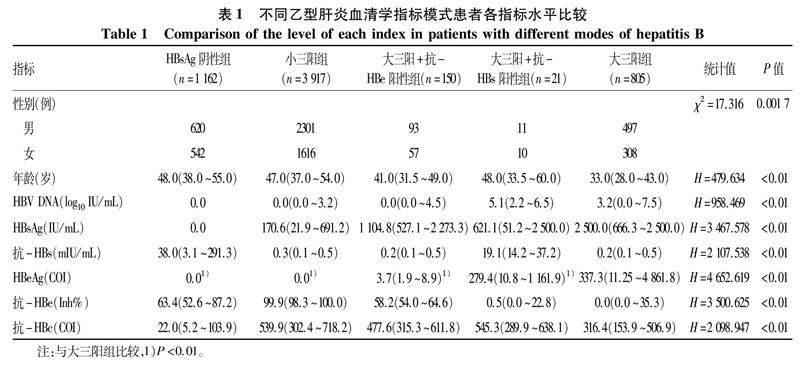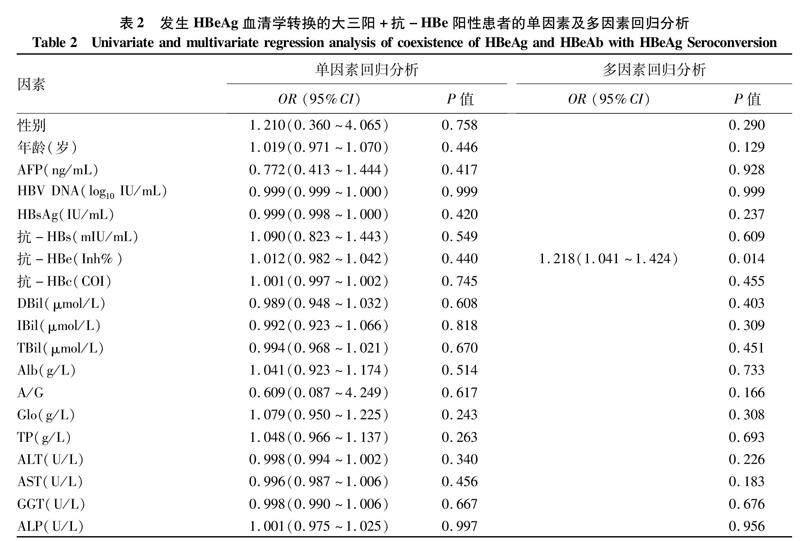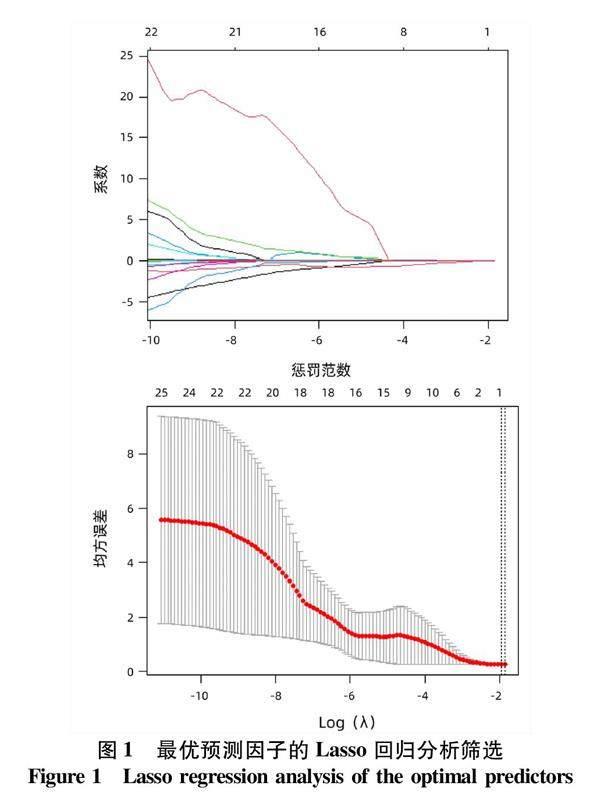抗-HBs聯合抗-HBe對HBsAg/HBeAg/抗-HBc陽性患者HBeAg血清學轉換的預測價值
譚亞峰 孫鳳蘭 夏巍 歐陽耀靈 李承彬 陳珍霞 吳松 余運運 江濤



摘要:目的建立HBsAg/HBeAg/抗-HBc陽性(以下簡稱“大三陽”)+抗-HBe陽性模式患者HBeAg血清學轉換預測模型,并驗證其預測價值。方法選取2018年4月1日—2022年8月1日于長江大學附屬荊州醫院行乙型肝炎血清標志物和HBV DNA定量檢測的乙型肝炎患者6 055例,根據不同乙型肝炎血清學指標模式分為5組:HBsAg陰性組、HBsAg/抗-HBe/抗-HBc陽性組、大三陽+抗-HBe陽性組、大三陽+抗-HBs陽性組和大三陽組。分析不同乙型肝炎血清學指標模式的特點及不同組別中HBeAg水平的差異。非正態分布的多組連續性變量組間比較采用Kruskal-Wallis H檢驗。計數資料組間比較采用χ2檢驗。采用線性回歸分析不同組別HBeAg水平差異。采用Logistic回歸篩選獨立影響因素,獲得最優預測因子。通過受試者工作特征曲線(ROC曲線)驗證預測效能。使用R Studio4.2.1建立預測模型并驗證。結果與大三陽模式相比,大三陽+抗-HBe陽性、大三陽+抗-HBs陽性模式患者HBeAg水平均降低(P值均<0.01)。多因素Logistic回歸分析顯示,抗-HBe是HBeAg血清學轉換的獨立影響因素(P=0.014)。Lasso回歸分析篩選結果顯示,大三陽+抗-HBe陽性患者發生HBeAg血清學轉換的最優預測因子為抗-HBe+抗-HBs。ROC曲線結果顯示,抗-HBe+抗-HBs的AUC為0.733(95%CI: 0.588~0.878,P=0.004 8)。納入抗-HBe+抗-HBs建立預測模型,其區分度(AUC=0.733)、準確度(C=0.733,B=0.20,P=0.946)、檢測效能及穩定度(加強Bootstrap檢驗C=0.726)均表現良好。結論乙型肝炎患者體內抗-HBs或抗-HBe的出現均促進HBeAg水平下降,且抗-HBe促進HBeAg水平下降的能力強于抗-HBs。抗-HBe+抗-HBs可用于大三陽+抗-HBe陽性模式患者HBeAg血清學轉換的預測。
關鍵詞:乙型肝炎抗原; 血清轉換; 預測
基金項目:荊州市科技計劃項目(2022HC68)
Predictive value of anti-HBs+anti-HBe for seroconversion of HBeAg in patients with positive?HBsAg/HBeAg/anti-HBc
TAN Yafeng SUN Fenglan XIA Wei OUYANG Yaoling LI Chengbin CHEN Zhenxia WU Song YU Yunyun JIANG Tao(a. Department of Clinical Laboratory, b. Department of Gynecology, Jingzhou Hospital Affiliated to Yangtze?University, Jingzhou, Hubei 434000, China)
Corresponding author:JIANG Tao, jiangtao00358@126.com (ORCID:0000-0002-0852-9190)
Abstract:ObjectiveTo establish a predictive model for HBeAg seroconversion in patients with positive HBsAg/HBeAg/anti-HBc and anti-HBe, and to investigate the predictive value of this model. MethodsA total of 6 055 patients with hepatitis B who received the quantification of the serum markers for hepatitis B and HBV DNA in Jingzhou Hospital Affiliated to Yangtze University from April 1, 2018 to August 1, 2022 were enrolled, and according to the pattern of serological markers for hepatitis B, they were divided into negative HBsAg group, positive HBsAg/anti-HBe/anti-HBc group, positive HBsAg/HBeAg/anti-HBc+positive anti-HBe group, positive HBsAg/HBeAg/anti-HBc+positive anti-HBs group, and positive HBsAg/HBeAg/anti-HBc group. The characteristics of different patterns of serological markers were analyzed, and the level of HBeAg was compared between groups. The Kruskal-Wallis H test was used for comparison of non-normally distributed continuous variables between multiple groups; the chi-square test was used for comparison of categorical data between groups. The linear regression analysis was used to analyze the difference in HBeAg content between different groups; the logistic regression analysis was used to screen for independent influencing factors and obtain the optimal predictive factors. The receiver operating characteristic (ROC) curve analysis was used to validate the predictive performance of the model. R Studio4.2.1 was used to establish and validate the predictive model. ResultsCompared with the positive HBsAg/anti-HBe/anti-HBc group, the positive HBsAg/HBeAg/anti-HBc+positive anti-HBe group and the positive HBsAg/HBeAg/anti-HBc+positive anti-HBs group had a significant reduction in the level of HBeAg? (both P<0.01). The multivariate logistic regression analysis showed that anti-HBe was an independent influencing factor for HBeAg seroconversion (P=0.014), and the Lasso regression analysis showed that anti-HBe+anti-HBs was the optimal predictive factor for HBeAg seroconversion in the patients with positive HBsAg/HBeAg/anti-HBc and positive anti-HBe. The ROC curve analysis showed that anti-HBe+anti-HBs had an area under the ROC curve (AUC) of 0.733 (95% confidence interval: 0.588-0.878, P=0.004 8). Anti-HBe+anti-HBs was included to establish a predictive model, which had good discriminatory ability (AUC=0.733), accuracy (C=0.733, B=0.20, P=0.946), predictive performance, and stability (C=0.726 based on the enhanced Bootstrap test). ConclusionThe presence of anti-HBs or anti-HBe in patients with hepatitis B promotes the reduction in HBeAg level, and anti-HBe had a stronger ability than anti-HBs in promoting such reduction. Anti-HBe+anti-HBs can be used to predict HBeAg seroconversion in patients with positive HBsAg/HBeAg/anti-HBc+positive anti-HBe.
Key words:Hepatitis B Antigens; Seroconversion; Forecasting
Research funding:Jingzhou Science and Technology Plan Project (2022HC68)
成人感染HBV后,大多數患者可通過自身免疫清除病毒,僅5%~10%的患者發展為慢性乙型肝炎[1]。HBsAg、HBeAg陽性能夠反映患者體內存在病毒復制,抗-HBs、抗-HBe及抗-HBc是患者免疫應答產生的抗體。HBeAg血清學轉換通常是指HBeAg消失后抗-HBe出現,是臨床抗病毒治療的重要目標之一[2-3]。國內外相關研究顯示,HBsAg/HBeAg/抗-HBc陽性(以下簡稱“大三陽”)乙型肝炎患者HBeAg血清學轉換受病毒及宿主雙方面的影響:(1)病毒方面,HBsAg、HBeAg、HBcrAg、HBV DNA及HBV RNA水平變化對HBeAg血清學轉換有一定的預測價值[4-17];宿主方面,抗-HBc及其水平變化對HBeAg血清學轉換也有一定預測價值[18-22]。隨著檢測技術的進步,越來越多特殊的乙型肝炎血清學指標模式被發現[23],包括大三陽+抗-HBe陽性模式和大三陽+抗-HBs陽性模式。目前,鮮有文獻報道上述特殊模式中抗-HBs、抗-HBe對HBeAg水平的影響,也尚未見有研究探討抗-HBs對乙型肝炎患者HBeAg血清學轉換有無預測價值。本研究通過分析不同乙型肝炎血清學指標模式,探討抗-HBs、抗-HBe對HBeAg水平的影響,建立預測模型,為此類乙型肝炎患者的疾病轉歸監測提供依據。
1資料與方法
1.1研究對象選取2018年4月1日—2022年8月1日于長江大學附屬荊州醫院行乙型肝炎血清標志物和HBV DNA定量檢測的乙型肝炎患者。乙型肝炎診斷標準參照中華醫學會《慢性乙型肝炎防治指南(2019年版)》[2]。排除標準:HAV、HCV感染,自身免疫性肝病以及藥物性肝損傷、酒精性肝損傷等。根據不同的乙型肝炎血清學指標模式,將研究對象分為5組:(1)HBsAg陰性組;(2)HBsAg/抗-HBe/抗-HBc陽性(以下簡稱“小三陽”)組;(3)大三陽+抗-HBe陽性組;(4)大三陽+抗-HBs陽性組;(5)大三陽組。
1.2研究方法
1.2.1觀察指標及檢測儀器乙型肝炎血清標志物采用HISCL 5000全自動化學發光法免疫分析儀(日本希森美康公司)檢測;血清HBV DNA定量采用ABI7500實時熒光定量聚合酶鏈式反應(PCR)儀(美國 ABI 公司)檢測;AFP采用Cobas e602全自動免疫分析儀(瑞士羅氏公司,Elecsys Ⅱ 定量方法)檢測。肝功能指標采用AU5800全自動生化分析儀(美國貝克曼庫爾特公司)檢測。所有儀器和試劑經過性能驗證,均符合ISO15189醫學實驗室質量及能力認證要求。
1.2.2陽性判斷標準(1)血清標志物陽性判斷標準為:HBsAg>0.03 IU/mL、抗-HBs>5 mIU/mL、HBeAg>1 COI、抗-HBe>50 抑制率(Inh%)、抗-HBc>1 COI。所有乙型肝炎特殊模式樣本均重復檢測且通過ELISA方法復核確認;HBsAg及抗-HBs為定量檢測,其單位分別為IU/mL及mIU/mL;乙型肝炎血清標志物半定量結果依據陰性質控品(Sysmex)(NC的發光強度)及陽性質控品(Sysmex)(PC的發光強度)計算獲得,①HBeAg通過質控品的發光強度計算臨界值(CO),即CO=(PC的發光強度-NC的發光強度)/50+NC的發光強度;然后計算檢測樣本的臨界值指數(COI),即COI=(樣本發光強度-NC的發光強度)/(CO-NC的發光強度),HBeAg>1 COI為陽性。②抗-HBe單位為Inh%,Inh%=(NC的發光強度-樣本發光強度)/(NC的發光強度-PC的發光強度),抗-HBe>50 Inh%為陽性。③抗-HBc通過質控品的發光強度計算CO,CO=(PC的發光強度-NC的發光強度)/5+NC的發光強度,然后計算檢測樣本的COI,COI=(樣本發光強度-NC的發光強度)/(CO-NC的發光強度),HBcAg>1 COI為陽性。(2)HBV DNA臨界值判斷標準為:HBV DNA>2 log10 IU/mL為陽性。血清HBV DNA定量檢測采用實時定量PCR法,HBV DNA擴增曲線呈“S”形,根據陽性參考品曲線自動換算出HBV DNA載量水平,HBV DNA>2 log10 IU/mL提示HBV DNA陽性,HBV DNA低于檢測下限用0 log10IU/mL表示。(3)AFP臨界值判定標準:AFP>7 ng/mL。(4)肝功能臨界值判定標準,男性:DBil>9.3 μmol/L、IBil>23.5 μmol/L、TBil>26 μmol/L、Alb<55 g/L、A/G>2.4、Glo>40 g/L、TP>85 g/L、AST>40 U/L、ALT>50 U/L、GGT>60 U/L、ALP>150 U/L;女性:DBil>7.5 μmol/L、IBil>18.9 μmol/L、TBil>21 μmol/L、Alb<55 g/L、A/G>2.4、Glo>40 g/L、TP>85 g/L、AST>35 U/L、ALT>40 U/L、GGT>50 U/L、ALP>150 U/L。
1.3統計學方法采用SPSS 26.0軟件進行統計學分析。計量資料以M(P25~P75)表示,組間比較采用Kruskal-Wallis H檢驗。計數資料組間比較采用χ2檢驗。采用Logistic回歸篩選獨立影響因素,增加Lasso(懲罰函數)消除共線性干擾獲得最優預測因子,通過受試者工作特征曲線(ROC曲線)驗證預測效能。使用R4.2.1建立預測模型并驗證。P<0.05為差異有統計學意義。
2結果
2.1一般資料共納入6 055例患者,HBsAg陰性組1 162例,小三陽組3 917例,大三陽+抗-HBe陽性組150例,大三陽+抗-HBs陽性組21例,大三陽組805例。
在大三陽+抗-HBe陽性中篩選出同期行乙型肝炎血清標志物、HBV DNA、AFP及肝功能檢測的患者,最終觀察到25例發生HBeAg 血清學轉換,其中5例獲得HBsAg陰轉。本研究根據25例大三陽+抗-HBe陽性患者HBeAg血清學轉換前后數據行單因素、多因素Logistic回歸及Lasso回歸分析,篩選出最優預測因子,應用最優預測因子建立大三陽+抗-HBe陽性患者HBeAg血清學轉換的預測模型并驗證。
2.2不同乙型肝炎血清學指標模式患者各項指標水平比較不同乙型肝炎血清學指標模式患者各項指標水平差異均有統計學意義(P值均<0.01)(表1)。
2.3不同乙型肝炎血清學指標模式患者HBeAg水平比較分層分析顯示:(1)大三陽+抗-HBs陽性患者由于抗-HBs的出現,其HBeAg含量較大三陽組低(P<0.01)。(2)大三陽+抗-HBe陽性患者由于抗-HBe的出現,其HBeAg含量較大三陽低(P<0.01)。(3)大三陽+抗-HBe陽性模式患者較大三陽+抗-HBs陽性模式患者HBeAg含量下降的更明顯。(4)大三陽、大三陽+抗-HBs陽性、大三陽+抗-HBe陽性與小三陽4種模式HBeAg水平呈階梯式降低趨勢。
2.4大三陽+抗-HBe陽性患者發生HBeAg血清學轉換的最優預測因子篩選及驗證根據已出現HBeAg血清學轉換的三陽+抗-HBe陽性患者數據進行探討,如表2所示,單因素回歸分析顯示,所有觀察指標均不是大三陽+抗-HBe陽性患者發生HBeAg 血清學轉換的獨立影響因素(P值均>0.05);多因素回歸分析顯示,抗-HBe是HBeAg血清學轉換的獨立影響因素(P=0.014)。提示抗-HBe在其他因素的協同作用下可促進HBeAg血清學轉換。
本研究進一步增加抗-HBe與抗-HBs、抗-HBc的不同協同模式及性別、年齡、AFP、HBV DNA、HBsAg、抗-HBs、抗-HBe、抗-HBc、DBil、IBil、TBil、TP、Alb、Glo、A/G、ALT、AST、GGT及ALP均納入Lasso回歸分析,應用懲罰函數消除共線性干擾,最終篩選出促進HBeAg血清學轉換最優預測因子為抗-HBe+抗-HBs(圖1)。ROC曲線分析顯示,抗-HBe+抗-HBs預測大三陽+抗-HBe陽性患者發生HBeAg血清學轉換的AUC=0.733(95%CI: 0.588~0.878,P=0.004 8)(圖2)。
2.5大三陽+抗-HBe陽性患者發生HBeAg血清學轉換預測模型的建立及驗證列線圖分析顯示,抗-HBe+抗-HBs是HBeAg血清學轉換的良好預測指標(圖3)。該模型的區分度良好(AUC=0.733)(圖4a)、準確度良好(C=0.733,B=0.20,P=0.946)(圖4b)、檢測效能良好(圖4c)及穩定度良好(加強Bootstrap檢驗C=0.726,檢驗曲線與模型校準曲線貼合良好)(圖4d)。
3討論
抗-HBs、抗-HBe和抗-HBc是患者免疫應答過程中產生的抗體,抗-HBc出現最早,抗-HBe常出現于HBeAg消失后,抗-HBs可出現于健康人群疫苗接種后或感染HBV病毒完全康復后[24]。在臨床實踐中常見大三陽+抗-HBe陽性和大三陽+抗-HBs陽性模式的患者,其發生機制尚不清楚,此特殊模式出現對HBeAg水平的影響以往鮮有文獻報道。本研究分層分析乙型肝炎不同模式對HBeAg水平的影響,證實了乙型肝炎患者體內抗-HBs或抗-HBe的出現均促進HBeAg水平的下降,且抗-HBe促進HBeAg水平的下降的效能強于抗-HBs。HBV 炎癥與免疫反應相關研究[25-26]顯示,抗-HBe為依賴T淋巴細胞介導的特異性抗體,對HBeAg具有較強的中和作用。故本研究認為大三陽+抗-HBe陽性患者HBeAg水平下降的原因可能是患者體內HBV病毒仍處于高復制狀態,而體內產生的抗-HBe對HBeAg具有一定的清除作用,最終表現為HBeAg水平下降且處于HBeAg與抗-HBe動態平衡狀態。另有國內外多項研究[27-30]顯示,患者發生HBeAg血清學轉換(HBeAg消失后出現抗-HBe)或HBsAg血清學轉換(HBsAg消失后出現抗-HBs)過程中可觀察到:細胞因子IL-21水平升高,NK細胞的活化性受體NKG2D、Toll樣受體表達上調及PD-1表達降低,CD56bright NK細胞數量、病毒特異性CD8 T淋巴細胞數量增加及調節性T淋巴細胞數量減少等現象。本研究推測,大三陽+抗-HBs陽性患者HBeAg水平下降的原因可能是患者免疫力較以前增強,促進了NK細胞、特異性CD8 T淋巴細胞數量的升高及調節性T淋巴細胞數量減少等而間接增強了機體清除HBV病毒的能力,從而促使了HBeAg含量下降。但該階段患者體內產生的抗-HBs為非HBeAg中和抗體,不能直接中和HBeAg,因此該模式促進HBeAg含量下降的效能較大三陽+抗-HBe陽性模式弱。
大三陽+抗-HBe陽性模式出現的原因已有學者探討,有學者[31]認為是由基因變異引起,即C區G1896A突變、BCP區A1762T/G1764A雙突變等,是HBV免疫逃逸的體現。另有學者[32]認為大三陽+抗-HBe陽性是感染了HBV不同亞型導致產生的抗-HBe無法中和體內的HBeAg所致。還有學者[33]指出HBeAg與抗-HBe是患者體內病毒復制和免疫清除動態平衡的體現,認為大三陽+抗-HBe陽性模式的出現是患者發生HBeAg血清轉化的過渡階段。本研究追溯到25例大三陽+抗-HBe陽性模式患者發生HBeAg血清學轉換,且有5例獲得HBsAg轉陰,驗證了大三陽+抗-HBe陽性模式可發生HBeAg血清學轉換,支持大三陽+抗-HBe陽性模式的出現是患者發生HBeAg血清學轉換的過渡階段的觀點。
《慢性乙型肝炎防治指南(2019年版)》[2]指出抗-HBe是大三陽患者HBeAg血清學轉換的影響因素,即HBeAg消失后出現抗-HBe為傳統的HBeAg血清學轉換方式。但大三陽+抗-HBe陽性模式HBeAg未消失體內便已出現抗-HBe,其能否發生HBeAg血清學轉換、轉化方式是否具有特殊性、有無良好的預測因子等方面值得深究。本研究驗證了大三陽+抗-HBe陽性模式可發生HBeAg血清學轉換,回歸分析結果表明,大三陽+抗-HBe陽性模式僅抗-HBe在其他因素的協同作用下可促進HBeAg血清學轉換。本研究增加抗-HBe與其他抗體不同的協同模式后,將所有影響因素均納入Lasso回歸分析,篩選出最優預測因子為抗-HBe+抗-HBs。ROC曲線分析證實,相較于抗-HBe,抗-HBe+抗-HBs是大三陽+抗-HBe陽性模式發生HBeAg血清學轉換更優的預測因子,基于抗-HBe+抗-HBs建立的預測模型,其區分度、準確度、檢測效能及穩定度均表現良好,可用于此類乙型肝炎患者治療過程的監測。
綜上所述,本研究再次證實了乙型肝炎患者體內抗-HBs或抗-HBe的出現均會促進HBeAg水平下降,抗-HBe促進HBeAg水平的下降的效能強于抗-HBs,首次探尋出抗-HBe+抗-HBs是大三陽+抗-HBe乙型肝炎患者HBeAg血清學轉換的最優預測因子。但本研究也有局限性:首先,藥物對HBeAg血清學轉換具有一定的影響,拉米夫定、恩替卡韋、阿德福韋酯、替比夫定治療的1年累計HBeAg血清學轉換率分別為17.24%、13.92%、15.95%和14.04%[8],但本研究未將藥物對HBeAg血清學轉換的影響納入研究模型。其次,HBV基因型及突變對HBeAg血清學轉換也有影響,B型HBV感染的HBeAg血清學轉換率最高,為15.5%,其次為C型7.9%及E型7.4%,1762T/1764A和1862T突變有利于HBeAg血清學轉換[34-36]。而本研究未行基礎實驗,未獲得HBV基因型及基因突變等預測因子的支持。本研究還缺乏多中心研究數據支持,未行外部驗證。后期筆者團隊將增加基礎實驗并開展廣泛合作,建立多中心數據庫進行模型開發與驗證。
倫理學聲明:本研究方案于2022年6月30日經由長江大學附屬荊州醫院倫理委員會審批,批號:2022-06-30,所納入患者均簽署知情同意書。利益沖突聲明:本文不存在任何利益沖突。作者貢獻聲明:譚亞峰、孫鳳蘭負責課題設計,資料分析,撰寫論文;夏巍,歐陽耀靈負責收集數據和統計分析;李承彬、陳珍霞、吳松負責指導數據統計分析;江濤負責擬定寫作思路,指導撰寫文章并最后定稿。譚亞峰、孫鳳蘭對本文貢獻等同,同為第一作者。
參考文獻:
[1]DUAN MX, GU YN, YU MC, et al. Reasons and clinical significance of HBeAg and anti-HBe double positive in patients with chronic hepatitis B[J]. Chin J Nosocomiology, 2017, 27(19): 4332-4335.段夢夕, 谷婭楠, 于淼琛, 等. 慢性乙型肝炎患者HBeAg與抗-HBe雙陽性的原因與臨床意義[J]. 中華醫院感染學雜志, 2017, 27(19): 4332-4335.
[2]Chinese Society of Infectious Diseases, Chinese Medical Association; Chinese Society of Hepatology, Chinese Medical Association. Guidelines for the prevention and treatment of chronic hepatitis B (version 2019) [J]. J Clin Hepatol, 2019, 35(12): 2648-2669. DOI: 10.3969/j.issn.1001-5256.2019.12.007.中華醫學會感染病學分會, 中華醫學會肝病學分會. 慢性乙型肝炎防治指南(2019年版)[J]. 臨床肝膽病雜志, 2019, 35(12): 2648-2669. DOI: 10.3969/j.issn.1001-5256.2019.12.007.
[3]GU ZY, WANG AH, HE WC, et al. Influencing factors for HBeAg seroconversion in patients with chronic hepatitis B[J]. J Clin Hepatol, 2022, 38(11): 2581-2585. DOI: 10.3969/j.issn.1001-5256.2022.11.029.顧子楊, 王安輝, 何文昌, 等. 慢性乙型肝炎患者HBeAg血清學轉換影響因素的研究進展[J]. 臨床肝膽病雜志, 2022, 38(11): 2581-2585. DOI: 10.3969/j.issn.1001-5256.2022.11.029.
[4]YAO CC, LEE CM, HUNG CH, et al. Combining age and HBsAg level predicts post-treatment durability of nucleos(t)ide analogue-induced HBeAg seroconversion[J]. J Gastroenterol Hepatol, 2015, 30(5): 918-924. DOI: 10.1111/jgh.12874.
[5]GISH RG, CHANG TT, LAI CL, et al. Quantitative hepatitis B surface antigen analysis in hepatitis B e antigen-positive nucleoside-naive patients treated with entecavir[J]. Antivir Ther, 2013, 18(5): 691-698. DOI: 10.3851/IMP2559.
[6]ZOULIM F, CAROSI G, GREENBLOOM S, et al. Quantification of HBsAg in nucleos(t)ide-nave patients treated for chronic hepatitis B with entecavir with or without tenofovir in the BE-LOW study[J]. J Hepatol, 2015, 62(1): 56-63. DOI: 10.1016/j.jhep.2014.08.031.
[7]YANG SC, LU SN, LEE CM, et al. Combining the HBsAg decline and HBV DNA levels predicts clinical outcomes in patients with spontaneous HBeAg seroconversion[J]. Hepatol Int, 2013, 7(2): 489-499. DOI: 10.1007/s12072-012-9382-3.
[8]GENG MF, LI YX, GAO FY, et al. A scoring model predicts hepatitis B e antigen seroconversion in chronic hepatitis B patients treated with nucleos(t)ide analogs: Real-world clinical practice[J]. Int J Infect Dis, 2017, 62: 18-25. DOI: 10.1016/j.ijid.2017.06.016.
[9]WANG Y, LIAO H, DENG Z, et al. Serum HBV RNA predicts HBeAg clearance and seroconversion in patients with chronic hepatitis B treated with nucleos(t)ide analogues[J]. J Viral Hepat, 2022, 29(6): 420-431. DOI: 10.1111/jvh.13671.
[10]WANG B, CAREY I, BRUCE M, et al. HBsAg and HBcrAg as predictors of HBeAg seroconversion in HBeAg-positive patients treated with nucleos(t)ide analogues[J]. J Viral Hepat, 2018, 25(8): 886-893. DOI: 10.1111/jvh.12889.
[11]HUANG YJ, CHANG CS, PENG YC, et al. On-treatment HBV DNA level could predict HBeAg seroclearance in patients with HBeAg-positive chronic hepatitis B with entecavir therapy[J]. J Chin Med Assoc, 2017, 80(6): 341-346. DOI: 10.1016/j.jcma.2016.12.005.
[12]PENG CY, HSIEH TC, HSIEH TY, et al. HBV-DNA level at 6 months of entecavir treatment predicts HBeAg loss in HBeAg-positive chronic hepatitis B patients[J]. J Formos Med Assoc, 2015, 114(4): 308-313. DOI: 10.1016/j.jfma.2013.10.023.
[13]JI X, XIA MY, ZHOU B, et al. Serum hepatitis B virus RNA levels predict HBeAg seroconversion and virological response in chronic hepatitis B patients with high viral load treated with nucleos(t)ide analog[J]. Infect Drug Resist, 2020, 13: 1881-1888. DOI: 10.2147/IDR.S252994.
[14]ZHANG M, LI GD, SHANG J, et al. Rapidly decreased HBV RNA predicts responses of pegylated interferons in HBeAg-positive patients: A longitudinal cohort study[J]. Hepatol Int, 2020, 14(2): 212-224. DOI: 10.1007/s12072-020-10015-3.
[15]YE F, ZHAO W, YANG X, et al. The decline of HBV RNA associated with HBeAg seroconversion and double-negative HBV DNA and RNA in chronic hepatitis B patients who received entecavir therapy: a 10-year retrospective cohort study[J].? Ann Transl Med, 2022, 10(16): 897. DOI: 10.21037/atm-22-3265.
[16]LUO H, ZHANG XX, CAO LH, et al. Serum hepatitis B virus RNA is a predictor of HBeAg seroconversion and virological response with entecavir treatment in chronic hepatitis B patients[J]. World J Gastroenterol, 2019, 25(6): 719-728. DOI: 10.3748/wjg.v25.i6.719.
[17]JIA W, ZHU MQ, QI X, et al. Serum hepatitis B virus RNA levels as a predictor of HBeAg seroconversion during treatment with peginterferon alfa-2a[J]. Virol J, 2019, 16(1): 61. DOI: 10.1186/s12985-019-1152-6.
[18]ZHAO XG, WANG J, LIU JC, et al. Baseline serum hepatitis B core antibody level predicts HBeAg seroconversion in patients with HBeAg-positive chronic hepatitis B after antiviral treatment[J]. Antiviral Res, 2021, 193: 105146. DOI: 10.1016/j.antiviral.2021.105146.
[19]WANG CT, ZHANG YF, SUN BH, et al. Models for predicting hepatitis B e antigen seroconversion in response to interferon-α in chronic hepatitis B patients[J]. World J Gastroenterol, 2015, 21(18): 5668-5676. DOI: 10.3748/wjg.v21.i18.5668.
[20]FAN R, SUN J, YUAN Q, et al. Baseline quantitative hepatitis B core antibody titre alone strongly predicts HBeAg seroconversion across chronic hepatitis B patients treated with peginterferon or nucleos(t)ide analogues[J]. Gut, 2016, 65(2): 313-320. DOI: 10.1136/gutjnl-2014-308546.
[21]CAI SH, LI ZD, YU T, et al. Serum hepatitis B core antibody levels predict HBeAg seroconversion in chronic hepatitis B patients with high viral load treated with nucleos(t)ide analogs[J]. Infect Drug Resist, 2018, 11: 469-477. DOI: 10.2147/IDR.S163038.
[22]FU XH, LOU HB, CHEN F, et al. Hepatitis B core antibody and liver stiffness measurements predict HBeAg seroconversion in HBeAg-positive chronic hepatitis B patients with minimally elevated alanine aminotransferase (ALT) levels[J]. Clin Exp Med, 2020, 20(2): 241-248. DOI: 10.1007/s10238-019-00603-5.
[23]XU WZ, TONG YQ, LI Y. Comparison of Roche Elecsys and Sysmex HISCL immunoassays for the screening of common blood-borne pathogens[J]. Ann Transl Med, 2019, 7(14): 300. DOI: 10.21037/atm.2019.05.83.
[24]WIJAYA RS, READ SA, TRUONG NR, et al. HBV vaccination and HBV infection induces HBV-specific natural killer cell memory[J]. Gut, 2021, 70(2): 357-369. DOI: 10.1136/gutjnl-2019-319252.
[25]TSUKUDA S, WATASHI K. Hepatitis B virus biology and life cycle[J]. Antiviral Res, 2020, 182: 104925. DOI: 10.1016/j.antiviral.2020.104925.
[26]KEENAN BP, FONG L, KELLEY RK. Immunotherapy in hepatocellular carcinoma: The complex interface between inflammation, fibrosis, and the immune response[J]. J Immunother Cancer, 2019, 7(1): 267. DOI: 10.1186/s40425-019-0749-z.
[27]CHEN T, ZHU L, SHI AC, et al. Functional restoration of CD56bright NK cells facilitates immune control via IL-15 and NKG2D in patients under antiviral treatment for chronic hepatitis B[J]. Hepatol Int, 2017, 11(5): 419-428. DOI: 10.1007/s12072-017-9803-4.
[28]HU X, MA S, HUANG X, et al. Interleukin-21 is upregulated in hepatitis B-related acute-on-chronic liver failure and associated with severity of liver disease[J]. J Viral Hepat, 2011, 18(7): 458-467. DOI: 10.1111/j.1365-2893.2011.01475.x.
[29]YANG JZ, SHENG GP, XIAO DS, et al. The frequency and skewed T-cell receptor beta-chain variable patterns of peripheral CD4(+)CD25(+) regulatory T-cells are associated with hepatitis B e antigen seroconversion of chronic hepatitis B patients during antiviral treatment[J]. Cell Mol Immunol, 2016, 13(5): 678-687. DOI: 10.1038/cmi.2015.100.
[30]XIA J, HUANG R, CHEN YX, et al. Profiles of serum soluble programmed death-1 and programmed death-ligand 1 levels in chronic hepatitis B virus-infected patients with different disease phases and after anti-viral treatment[J]. Aliment Pharmacol Ther, 2020, 51(11): 1180-1187. DOI: 10.1111/apt.15732.
[31]AN X, LIU SH, XIA LN, et al. Efficacy and clinical outcomes of different antiviral regimens in HBeAg/HBeAb double-positive patients with chronic hepatitis B[J]. J Army Med Univ, 2022, 44(2): 162-167. DOI: 10.16016/j.2097-0927.202107114.安選, 劉書宏, 夏莉娜, 等. HBeAg/HBeAb雙陽性慢性乙型肝炎患者不同抗病毒方案療效及臨床轉歸分析[J]. 陸軍軍醫大學學報, 2022, 44(2): 162-167. DOI: 10.16016/j.2097-0927.202107114.
[32]LUO L, ZHANG TC, LIU SG. Clinical characteristics of chronic hepatitis B patients with both HBeAg and HBeAb positive[J]. J Mol Diagn Ther, 2019, 11(5): 387-390, 433. DOI: 10.3969/j.issn.1674-6929.2019.05.011.羅琳, 張廷超, 劉書剛. HBeAg與抗-HBe雙陽性的慢性乙型肝炎患者臨床特征分析[J]. 分子診斷與治療雜志, 2019, 11(5): 387-390, 433. DOI: 10.3969/j.issn.1674-6929.2019.05.011.
[33]WANG H, WANG HP, QIAN LY, et al. Maternal breast feeding safety of hepatitis B virus carrying parturient women with hepatitis B surface antigen and hepatitis B e antigen double positive[J]. Chin J Infect Dis, 2020, 38(1): 44-48. DOI: 10.3760/cma.j.issn.1000-6680.2020.01.006.王虹, 王紅萍, 錢琳妍, 等. 乙型肝炎表面抗原和乙型肝炎e抗原雙陽性的乙型肝炎病毒攜帶產婦進行母乳喂養的安全性[J]. 中華傳染病雜志, 2020, 38(1): 44-48. DOI: 10.3760/cma.j.issn.1000-6680.2020.01.006.
[34]KAO JH, CHEN PJ, LAI MY, et al. Hepatitis B virus genotypes and spontaneous hepatitis B e antigen seroconversion in Taiwanese hepatitis B carriers[J]. J Med Virol, 2004, 72(3): 363-369. DOI: 10.1002/jmv.10534.
[35]SHIMAKAWA Y, LEMOINE M, NJAI HF, et al. Natural history of chronic HBV infection in West Africa: A longitudinal population-based study from The Gambia[J]. Gut, 2016, 65(12): 2007-2016. DOI: 10.1136/gutjnl-2015-309892.
[36]KRAMVIS A, KOSTAKI EG, HATZAKIS A, et al. Immunomodulatory function of HBeAg related to short-sighted evolution, transmissibility, and clinical manifestation of hepatitis B virus[J]. Front Microbiol, 2018, 9: 2521. DOI: 10.3389/fmicb.2018.02521.
收稿日期:2022-12-02;錄用日期:2023-01-09
本文編輯:邢翔宇
引證本文:TAN YF, SUN FL, XIA W,? et al. Predictive value of anti-HBs+anti-HBe for? seroconversion of HBeAg in patients with positive HBsAg/HBeAg/anti-HBc[J]. J Clin Hepatol, 2023, 39(8): 1832-1840.

